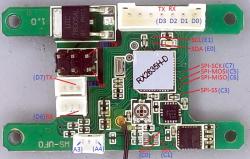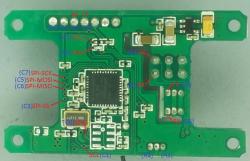Walkera RX2635H as generic development board?
Wednesday, December 30, 2015
Walkeras quadcopter brains RX2635H for the Hoten-X and RX2634H for the QR-Ladybird feature an Altera XMEGA32*A4U (which has quite some peripherals and memory) and sensors like gyros and even a wireless USB transmitter. You can get such a board either from an old crashed quadcopter or relatively cheap from the internet like ebay.
- Flashing new Firmware to Walkera RX/TX without UP02
- Decrypting receiver firmware
- Walkera receiver components
- Hello World firmware for the RX2635H board
- Serial port and external 16MHz oscillator
- Using the ITG-3205 mems gyro
- Walkera UP02 software clone: UP42
- Walkera RX2635H as generic development board? (this post)
- Walkera USB port
- Walkera + Arduino = Walkino
As described in another article (see links above), these boards can be programmed easily with a custom firmware. This can be as simple as letting the LED on the board blink up to some more sophisticated projects like (as we have gyros and accelerometers on board) a fitness tracker.
Problem is that not all available peripheral ports of the XMEGA are available on the board on sockets. In fact only a few are available
on sockets but some more can be tapped on solder points or tracks on the board and some other are completely unavailable. But the most important ones are:
- some few general I/O pins
- two serial ports
- two IC2 ports
- one SPI port
This should be enough to build some interesting projects.
The following pictures show which ports are available where on the RX2635H board.
The MMA-8452Q 3-axis accelerometer is connected to the I2C bus with address 0×1C on XMEGAs Port-C and the ITG-3205 3-axis MEMS gyro to the I2C bus with address 0×68 on Port-E. The Cypress Wireless USB CYRF-6936 is connected via SPI to Port-C. The main serial port which is used during boot by the integrated boot loader to load new firmware to the XMEGA is on Port-D and available on sockets. Also a second serial port on Port-D is available on a socket.
So with a little soldering additional hardware can easily be connected to the receiver board. Think of a GPS receiver on the second serial port or to use the board for a completely different purpose.

